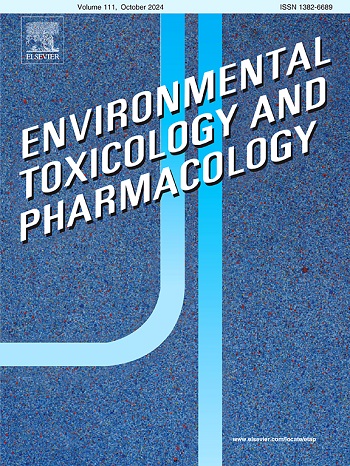Tebuconazole-based fungicide impairs embryonic development of the South African Clawed Frog Xenopus laevis
IF 4.2
3区 环境科学与生态学
Q2 ENVIRONMENTAL SCIENCES
引用次数: 0
Abstract
Tebuconazole (TBZ) is a broad-spectrum fungicide that disrupts fungal cell membrane. Due to its extensive application in agriculture, TBZ is frequently detected in aquatic ecosystems, posing potential risks to amphibians. However, the effects of TBZ-based formulations on amphibian development remain poorly understood. The present study investigates the effects of the TBZ-based fungicide Tebucur on the embryogenesis of the South African clawed frog. Two-cell stage embryos were exposed to varying concentrations of Tebucur (0.01–100 mg a.i./L) in a static non-renewal bioassay. The exposure time varied between four and 14 days, depending on the desired developmental stage of the embryos and the analysis method. Tebucur exposure resulted in mortality with a LC50-value of 8.0 mg a.i./L at 14 days. As well, various morphological abnormalities during neural and cardiac development emerged. Additionally, a reduction of overall mobility was observed. This underlines the need for strict regulation of the use of TBZ-formulations.

以替布康唑为基础的杀菌剂损害南非爪蟾的胚胎发育
戊康唑(TBZ)是一种破坏真菌细胞膜的广谱杀菌剂。由于其在农业中的广泛应用,在水生生态系统中经常被检测到,对两栖动物构成潜在风险。然而,基于tbz的配方对两栖动物发育的影响仍然知之甚少。本文研究了以tbz为基础的杀菌剂Tebucur对南非爪蛙胚胎发生的影响。在静态不更新生物测定中,两细胞期胚胎暴露于不同浓度的Tebucur(0.01-100 mg a.i./L)。暴露时间从4天到14天不等,取决于所需的胚胎发育阶段和分析方法。暴露于Tebucur导致死亡,14天lc50值为8.0 mg a.i./L。在神经和心脏发育过程中也出现了各种形态异常。此外,观察到整体活动能力降低。这强调需要严格管制ttbz配方的使用。
本文章由计算机程序翻译,如有差异,请以英文原文为准。
求助全文
约1分钟内获得全文
求助全文
来源期刊
CiteScore
7.00
自引率
4.70%
发文量
185
审稿时长
34 days
期刊介绍:
Environmental Toxicology and Pharmacology publishes the results of studies concerning toxic and pharmacological effects of (human and veterinary) drugs and of environmental contaminants in animals and man.
Areas of special interest are: molecular mechanisms of toxicity, biotransformation and toxicokinetics (including toxicokinetic modelling), molecular, biochemical and physiological mechanisms explaining differences in sensitivity between species and individuals, the characterisation of pathophysiological models and mechanisms involved in the development of effects and the identification of biological markers that can be used to study exposure and effects in man and animals.
In addition to full length papers, short communications, full-length reviews and mini-reviews, Environmental Toxicology and Pharmacology will publish in depth assessments of special problem areas. The latter publications may exceed the length of a full length paper three to fourfold. A basic requirement is that the assessments are made under the auspices of international groups of leading experts in the fields concerned. The information examined may either consist of data that were already published, or of new data that were obtained within the framework of collaborative research programmes. Provision is also made for the acceptance of minireviews on (classes of) compounds, toxicities or mechanisms, debating recent advances in rapidly developing fields that fall within the scope of the journal.

 求助内容:
求助内容: 应助结果提醒方式:
应助结果提醒方式:


